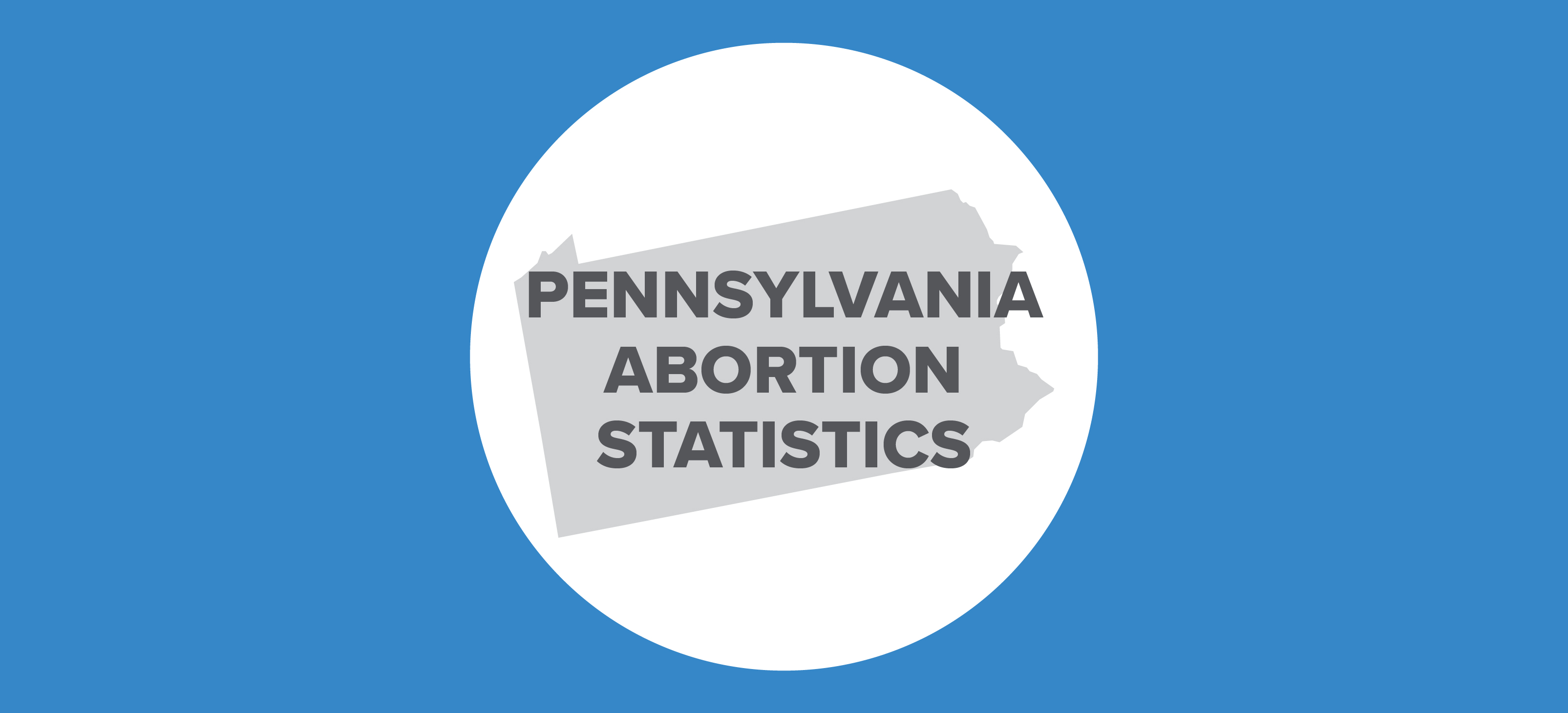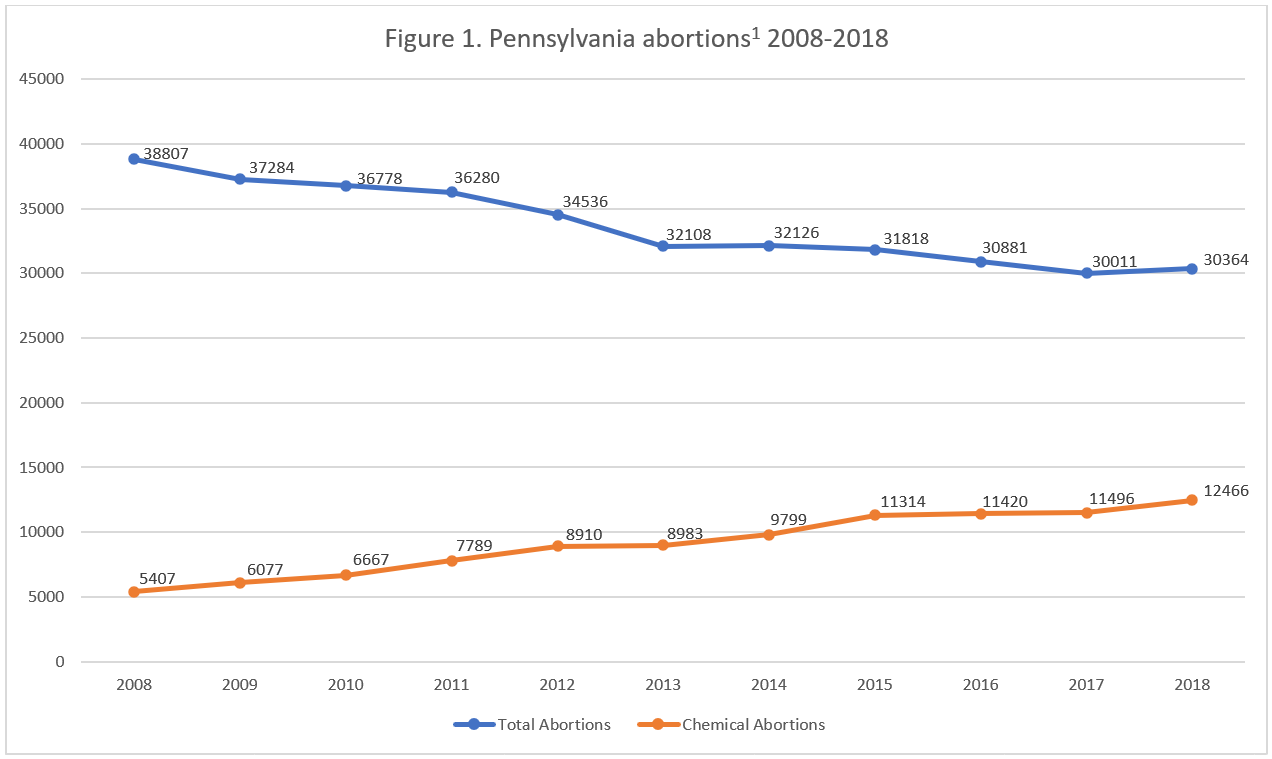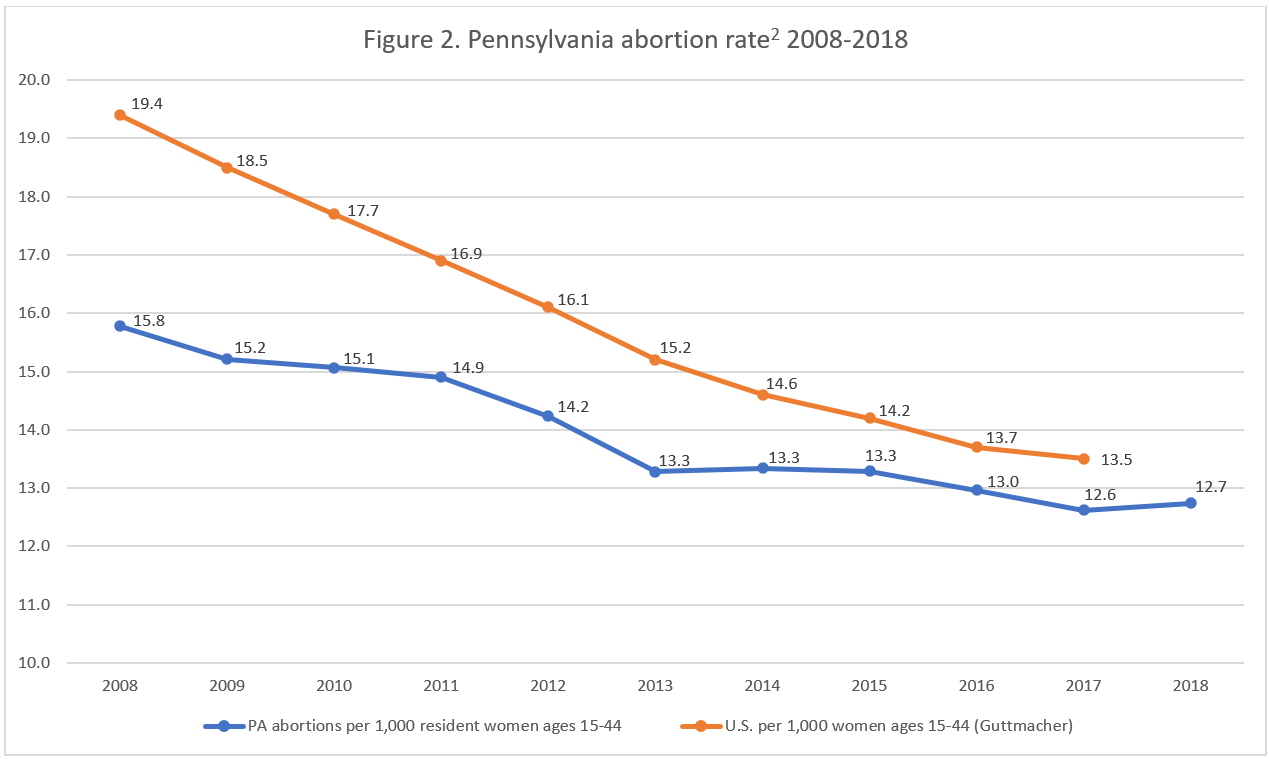Abortion Reporting: Pennsylvania (2018)

Pennsylvania’s annual abortion report for 2018 was published by the Pennsylvania Department of Health in December 2019. The report shows that abortions in the Keystone State increased from the previous year after several years of decline.
Changes in Pennsylvania Abortions, 2017-2018

Information on Planned Parenthood’s Pennsylvania market share is not publicly available.
Abortion Totals and Trends
In 2018, there were 30,364 abortions reported in Pennsylvania, up one percent from 2017. Of these, 12,466 (41 percent) were chemical abortions. Chemical abortions increased by eight percent from the year before (Fig. 1). However, Pennsylvania abortions have declined by 54 percent from 1980, Pennsylvania’s highest reported total. The Charlotte Lozier Institute estimates that Pennsylvania’s abortion rate in 2018 was 12.7 abortions per 1,000 women ages 15 to 44, close to the national rate (Fig. 2).
State Report Summary
Ninety-three percent of the abortions reported in Pennsylvania in 2018 were performed on Pennsylvania residents, while seven percent were performed on nonresident women. Women from Delaware made up the largest group of nonresident women traveling to Pennsylvania for abortions, undergoing three percent of all abortions reported in the state.
Nine percent of Pennsylvania abortions were performed on girls under the age of 20. Fifty-nine percent were on women in their twenties, with 28 percent on women ages 20 to 24 and 30 percent on women ages 25 to 29. Twenty-nine percent were on women in their thirties (19 percent on women ages 30 to 34 and 11 percent on women ages 35 to 39). Three percent of Pennsylvania abortions were performed on women age 40 or older.
Similar to previous years, white women composed the largest racial group at 48 percent, followed by African-American women at 43 percent. Four percent of the abortions were on Asian or Pacific Islander women. Three percent were on women of multiple races, one percent on women of other races, and less than half a percent on women of unknown race. Ten percent of the abortions were on Hispanic women, and 90 percent were performed on non-Hispanic women.
Just over half the women obtaining abortions in Pennsylvania had never had an abortion before (52 percent). A quarter had one previous abortion, and 22 percent had more than one. Sixty-two percent already had children, with 26 percent with one previous live birth and 36 percent with two or more prior live births. Eighty-eight percent of the abortions were performed on unmarried women, and 12 percent were on married women.
Sixty-two percent of Pennsylvania abortions occurred at eight weeks of gestation or earlier. Seventeen percent were performed between nine and 10 weeks, and eight percent occurred between 11 and 12 weeks of gestation. Five percent of the abortions were performed early in the second trimester between 13 and 14 weeks, dropping to four percent between 15 and 17 weeks of gestation. Not quite three percent occurred between 18 and 20 weeks, and 1.5 percent were performed between 21 and 23 weeks. No abortions were reported at 24 weeks or later.
Suction curettage was the most common abortion procedure, used to perform 54 percent of Pennsylvania abortions in 2018. Another 41 percent were chemical abortions, and five percent were performed using dilation and evacuation. There were just 20 sharp curettage procedures, one intra-uterine instillation abortion, and one hysterotomy or hysterectomy abortion. A large number of suction curettage abortions (1,410 abortions) were reported at 15 weeks of gestation or later, despite the fact that suction curettage is a first trimester procedure. When asked by CLI to clarify, the Pennsylvania Department of Health responded that these suction curettage procedures were indeed reported to have been performed in the second trimester, but did not provide any additional explanation.
Pennsylvania collects abortion complication data from two sources: the abortion reporting form that abortion providers submit, and an abortion complication reporting form that health care providers can use to report complications they treat.1
There were 179 abortion complications reported in 2018 using the abortion complication reporting form, up from 143 the year before. These were reported by doctors who treated women for abortion-related complications, and the Pennsylvania Department of Health does not attempt to reconcile the complication reports with the abortion reporting forms received from abortion providers. Most of the reported complications, 58 percent, were caused by chemical abortions. Nineteen percent resulted from suction curettage abortions. Eleven percent of the complications were caused by sharp curettage procedures and another 11 percent by dilation and evacuation abortions. One percent were caused by unknown abortion methods. Six percent of the complications occurred to girls under the age of twenty, 58 percent to women in their twenties, 32 percent to women in their thirties, and four percent to women age 40 and older. Eighty-four percent of the complications were caused by first-trimester abortions and 13 percent by second-trimester abortions, with six percent resulting from abortions performed between 21 and 23 weeks of gestation. Three percent of the complications were caused by abortions performed at unknown gestational ages.
There were also 219 medical complications reported at the time of the abortion. Three of these were the result of the abortion, and 213 were pre-existing complications that could complicate pregnancy. The report does not provide any details on these pre-existing conditions, but Pennsylvania’s abortion reporting statute indicates these would include conditions such as “hydatid mole, endocervical polyp, malignancies, radiation exposure, genetic indications, psychological indications, rape, incest and rubella disease.”
Pro-Life Bills in Pennsylvania
In 2019, the Pennsylvania legislature passed a bill to prohibit an abortion from being performed simply because the baby was diagnosed with Down Syndrome. Similar laws have been enacted in a growing number of states. Courts have blocked the laws as unconstitutional in some states, but U.S. Supreme Court Justice Clarence Thomas has clarified that this is an issue of first impression, and the Supreme Court has not yet ruled on the constitutionality of Down Syndrome abortion prohibitions. However, Pennsylvania Governor Tom Wolf vetoed Pennsylvania’s bill. Two years earlier, Governor Wolf also vetoed a bill that would have limited abortions on unborn babies who can feel pain.
State Ranking
In CLI’s review of abortion reporting across the county, Pennsylvania’s reporting was ranked at 23rd best. Pennsylvania could include information on the number of abortions performed at each abortion center in the state. According to state law, abortion facilities that receive public funding must file quarterly reports with the Department of Health, and Pennsylvania could add this information to its annual abortion reports. Additionally, with a large number of abortions performed late in pregnancy between 21 and 23 weeks of gestation, Pennsylvania could report whether any babies were born alive during abortions as well as the reasons cited for obtaining an abortion so late in pregnancy.


- Statistics on abortion complications reported here represent a minimal number of deaths and complications, as this data is collected in a non-systematic and non-verifiable way. As such, this data cannot be used to calculate either an accurate abortion mortality rate or an accurate abortion complication rate for the state.
- Starting with the 2018 abortion reports, abortion rates are calculated by the Charlotte Lozier Institute to allow for easier state-to-state and year-to-year comparisons. Rates were calculated by CLI using population estimates from the United States Census Bureau. The rates were calculated using the following formula: (total number of abortions performed in Pennsylvania ÷ number of resident women ages 15-44) x 1,000. Rates may differ slightly from previous CLI articles due to revised population estimates.























